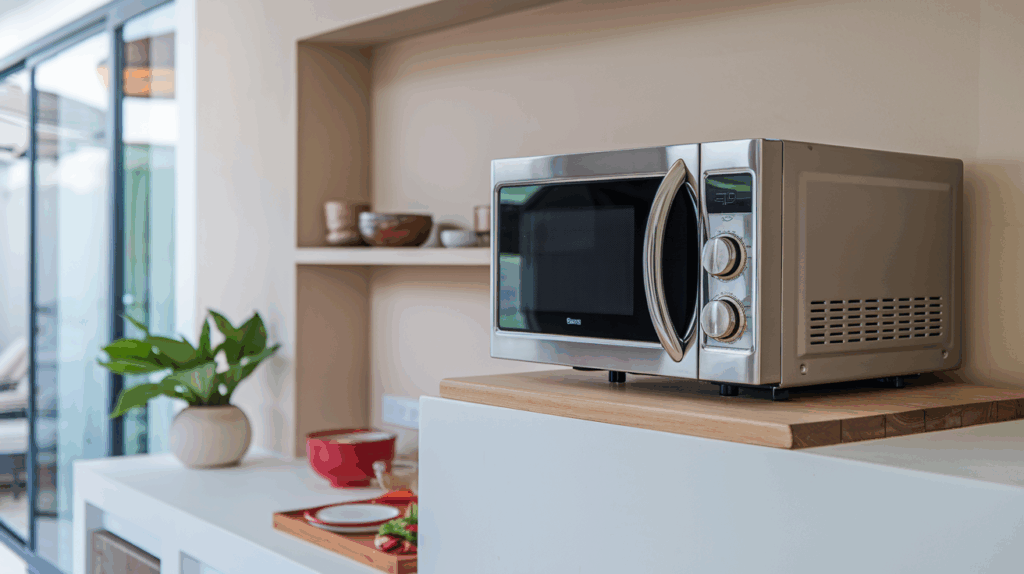
A microwave turntable rotates the glass plate so food heats evenly. If it stops spinning, some parts of your meal might be overcooked while others stay cold.
Several factors can cause this issue. Below are troubleshooting steps to help fix it.
Common Causes of a Non-Spinning Turntable
Several factors might stop the turntable from rotating. Checking these can help diagnose the problem before attempting repairs:
- Dirty or misaligned microwave turntable components – Food debris or an improperly seated glass plate can prevent movement.
- Faulty turntable motor – If the motor burns out or loses connection, the turntable won’t spin.
- Damaged coupler or drive bushing – If the plastic or rubber coupler connecting the motor to the turntable cracks or wears out, rotation may stop.
- Broken roller guide – Wheels underneath the turntable must roll freely. If they are misaligned or damaged, movement is affected.
- Control board issues – A faulty circuit board can disrupt signals to the turntable motor.
Safety First
Microwaves contain high-voltage components, which can be dangerous if handled incorrectly. Keep these safety precautions in mind:
- Always unplug the microwave before inspecting or repairing it.
- Discharge the high-voltage capacitor before touching internal components.
- Never power the microwave on without the cover securely in place.
- Wear insulating gloves and use insulated tools when handling internal parts.
- Inspect all components for damage before reassembling and turning the microwave back on.
How to Discharge a Capacitor
Warning: Microwave capacitors store high voltage, which can be extremely dangerous. If you’re not comfortable handling electrical components, it’s best to seek professional help. Always follow manufacturer guidelines for safety.
- Unplug the microwave to disconnect it from power.
- Use a screwdriver with a well-insulated handle to prevent electric shock.
- Touch the insulated part of the screwdriver blade to one terminal of the capacitor.
- Slowly slide the blade toward the other terminal and hold it in place for a few seconds. This process may produce a loud popping sound.
- Repeat this step for each terminal to fully discharge the capacitor.
- If the capacitor has three terminals, apply the same method to each one.
How to Fix a Microwave Turntable That Isn’t Spinning
Below are the steps to troubleshoot and fix a microwave turntable that has stopped spinning.
Check the Turntable Motor Setting
- Look at the microwave control panel for an on/off button for a turntable. Some models allow manual control of the turntable.
- Press the button and listen for a relay click to confirm that the control board is sending a signal.
- If the button does not work, the touchpad or control panel assembly may need to be replaced.
Inspect the Turntable Support
- Remove the turntable to access the support ring.
- Check for cracks, broken pieces, or worn-out ball bearings or wheels.
- If the support is damaged, replace it with a new one.
Check the Turntable Coupler
- Unplug the microwave for safety.
- Remove the turntable and shaft to access the coupler.
- Examine the coupler for cracks or signs of wear.
- If the coupler is damaged, replace it and make sure it fits securely onto the motor shaft.
Test the Turntable Motor
- Unplug the microwave and remove the bottom panel to reach the motor.
- Use a multimeter to check for resistance in the motor windings.
- A functional motor should show a resistance of about 40 ohms.
- If the motor has no resistance or a significantly different reading, replace it.
Check the Control Board
- If all other components are working, test whether the motor is receiving voltage.
- If the motor is not getting power, the control board may be faulty.
- Replace the control board only if other possible issues have been ruled out.
When to Seek Professional Help
If troubleshooting doesn’t fix the issue, professional repair may be necessary. Consider calling a technician in these cases:
- The motor is unresponsive – If replacing the motor does not restore movement, the problem may be electrical.
- There is a burning smell – A damaged motor or wiring issue can cause overheating, requiring expert attention.
- The microwave sparks or makes unusual noises – Internal electrical issues should not be ignored, as they pose a fire hazard.
- DIY repair attempts feel unsafe – If you’re unsure about handling internal components, professional repair is the safer choice.
- Other microwave functions are affected – If buttons, heating, or the light stop working along with the turntable, there could be a larger issue with the control board.
In Summary
If your microwave turntable stops moving, your food might heat unevenly, and it could signal a bigger problem. Sometimes, the issue is as simple as cleaning up food particles or adjusting the turntable parts. Other times, a broken motor or control board could be the cause.
If you’ve checked everything and it still won’t turn, don’t ignore it. A malfunctioning microwave can be risky, and using it with faulty parts might cause more damage. When fixing it yourself doesn’t work, calling a professional is the safest option. A quick repair now could save you from a costly replacement later.
